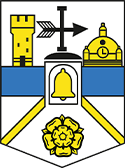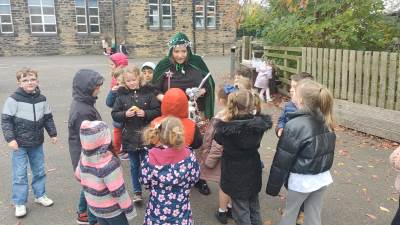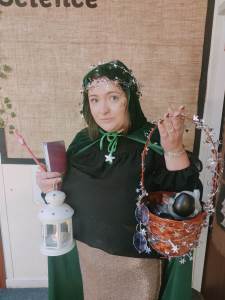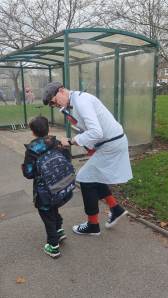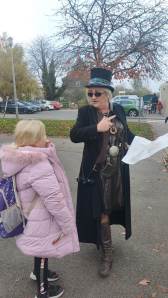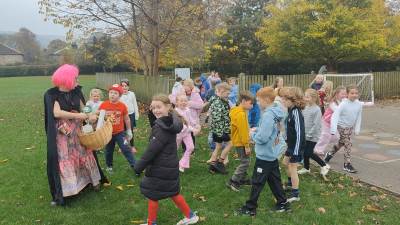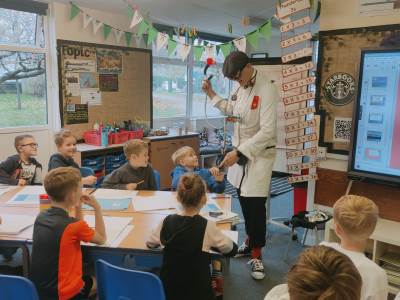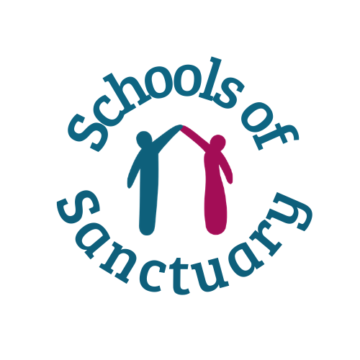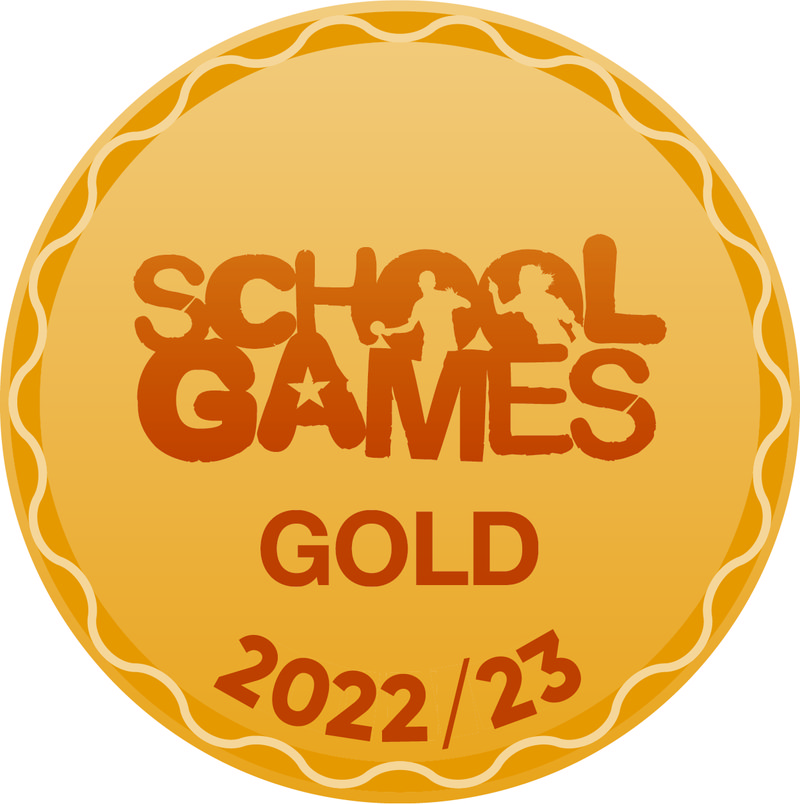Our Writing Curriculum
Intent
We strive to give our children the best start in establishing secure foundations in writing. Our primary intent is to create avid readers which we believe is the foundation for any great writer. We foster automaticity in transcriptional skills while a huge amount of high quality reading and motivation supports cohesion and creativity. We recognise the importance of nurturing a writing culture; creating writers and story-tellers who take pride; write clearly and accurately; and select and adapt language and style to suit a range of contexts, purposes and audiences.
Using the Talk for Writing approach, we plan engaging units of work in order to enthuse, inspire and motivate our children, which are underpinned by core texts from our carefully developed reading spine.
It is our intention that by the end of their primary education, all of our pupils will be able to speak and write fluently so that they can communicate their ideas effectively and with a developed awareness for purpose and audience. We aim to centralise oracy within our curriculum both in English and beyond so that children quickly develop in confidence whilst embedding their core communication skills and subsequently develop as articulate citizens.
Implementation of Transcriptional Development
We understand that automaticity in the transcriptional skills of spelling and handwriting are crucial for literacy success.
We want all of our children to reach automaticity in writing transcription in order to support their scholastic progress, not only in writing, but across the curriculum. Children need to be able to prioritise the discipline of the subject they are actively learning without cognitive load being taken up by the complex, multi-faceted skills of handwriting and spelling. In writing lessons, focus soon switches to composition and without a developing automaticity of transcription, children simply do not have the cognitive space to meet the creative demands of composition. It is much like with reading where automaticity in decoding and blending is a vital foundation for later comprehension and similar to maths, where foundational fluency is essential to tackle more complex reasoning and problem solving.
Handwriting
Our handwriting progression is taken from the National Curriculum English Programme of Study and is supported by the schemes: Little Wandle Letters and Sounds and Nelson Handwriting. The letter formation that our youngest children first encounter is pre-cursive and set out in the sequence of teaching for phonics using Little Wandle. Each grapheme is taught using a visual mnemonic and formation phrase and these are displayed in all Early Years and Year One classrooms. Alongside the initial teaching of how letters are formed and beyond, we choose to follow the Nelson Handwriting scheme as we recognise the complexities in the sequence of teaching handwriting so to ensure progression throughout and across the years, this scheme offers a stability in progression as well as sufficient deliberate practise of the physical skill handwriting.

We use a progression of tramlines to ensure that our children are supported well in their developing letter formation. Not only is it important that each letter starts and ends in the correct way to better aid joining in year two, but children must also use correct spacing and sizing of letters in relation to each other. To support our children’s developing spacing, sizing, ascenders and descenders we use a yellow highlighted tramline which is 18mm until the end of Year Two, decreases to 12mm for Lower Key Stage Two and when children are ready (showing consistent letter formation including spacing and sizing), the tramlines are removed. In classes where tramlines are used by all or most children, all writing by the teacher is modelled in the way to set the example.

Little Wandle Letters and Sounds to Spelling Shed
Our youngest children begin to learn how to spell through their phonics sessions delivered by the scheme, ‘Little Wandle Letters and Sounds.’ It is recognised that a sound to print approach is best and, in this way, as our children learn to read through segmenting and blending they simultaneously learn to spell using their knowledge of phoneme / grapheme representation.
Spelling Shed
From year two onwards, our children receive regular teaching of spelling through the use of spelling shed. The carefully selected word lists and engaging activities provide opportunities to incorporate phonics and meaning to strengthen spelling skills and build vocabulary acquisition.
Implementation of Compositional Writing Development
Talk for Writing is the developmental exploration through talk, of the thinking and creative process involved in being a writer. By focussing on the oral retelling of various text types, familiar structures become fully embedded in the long term memory so that the children can later apply these structures to their own writing whilst developing the language techniques taught for the particular area of focus. For example, children may be writing using the structure of a portal story whilst developing their understanding of what makes an effective setting description.
Core quality texts, from our well-developed reading spine, stand at the core of our English planning where we strive to intrinsically integrate the teaching of reading and writing. Children engage deeply with carefully selected texts as we foster their ability to: read as readers, read as writers and finally become independent writers and story-tellers.
The primary aim of the reading spine is that we expose the children to a range of high quality literature over the course of their primary school life. In this way, we are able to assist the children in their development of a rich vocabulary and of texts which are written with careful precision to captivate their audience. Teachers create model texts for specific writing units which aim to build the child’s narrative storehouse as well as demonstrate the language techniques which are to be taught and developed.
During each writing unit, our children are guided through the processes of: Imitation; Innovation and Independent Application; we believe in using great writing models as well as being great writing models.
Units of work are personalised to the class needs through a baseline assessment where teachers are able to identify whole-class targets for the development of grammatical writing skills. Daily target teaching is then planned within the writing unit to ensure children are given sufficient time to deliberately practise and demonstrate their development in skill, in the context of the chosen story type and writing focus.
Imitation: Throughout a writing unit, the writing focus will be developed through internalisation and contextualisation of a model where children deepen their understanding of a particular text type. During this stage, children deepen their understanding of the text through various techniques such as: drama, comprehension, role-play and small-world.
Carefully planned word, sentence and grammar play as well as ‘short-burst writing’ and ‘target-teaching’ throughout, allows teachers to teach and model writerly knowledge and grammar and supports children to develop, play with, manipulate and bank language daily.
During the imitation stage the class will spend time exploring other text examples through wider whole-class reading and will also co-construct a ‘tool-kit’ for purposeful writing.
Innovation: Once children have deeply embedded the structures and techniques of the model text(s) as well as developed their writing towards targets, they move onto the innovation stage. Here, the whole class are guided through the process using shared writing. The level of innovation will depend on the age and stage of the children.
Writing is always modelled by the teacher through shared-writing sessions and daily feedback ensures that children make sufficient progress.
In EYFS and Y1, children begin to innovate texts with simple levels of innovation such as substitution and in later years move towards more complex innovations such as a change in viewpoint; writing a sequel or blending story patterns. Where children are not yet ready to write down their innovations, they will rehearse, internalise and re-tell their stories and recounts orally.
Throughout Nursery and Reception, we place a greater emphasis on the imitation stage – ensuring our children successfully learn and embed each and every model text while achieving a basic level of comprehension. This is achieved through daily taught sessions where teachers guide the children towards independent oral re-telling of the text as well as carefully planned and well-matched provision activities which allow the children to deepen and embed their learning throughout independent provision and focus groups.
In readiness for Year One, we are ambitious in our drive to move children from oral re-telling to writing as soon as possible.
Independent Application: At the end of the writing unit, once children have moved through the stages of imitation and innovation, developing their narrative storehouses, vocabulary banks and grammatical competence, they complete an independent application task in order to fulfil a planned purpose.
For children who are not writing, oral re-telling is recorded for assessment purposes. Here, children use and apply the writing and language skills they have acquired in an effort to ‘show-what-they-know’. Teachers are then able to assess the writing progress for the unit as well as create a series of next-steps for their class.
Our youngest children begin their week with the opportunity to recount events from the weekend, or are provided with a stimulus e.g. a fictional event to write about. This promotes freedom, creativity and independence in writing.
Invention: We acknowledge that just as with reading, writing requires the time and space to appreciate, to practise, to have more freedom about what and how to write - this after all is how it is to BE a writer. Our writing curriculum is carefully designed to create story-tellers and writers who have a wealth of imagination, subject knowledge and writerly tools/skills to draw upon. We expose children to a huge amount of quality examples of literature, help them to read appreciatively and critically as a writer and cumulatively build up their skills in composition so that they write not only for their own enjoyment but as entertainers, with a keen eye for the effect they will draw from their audiences. With this in mind, we recognise that time and space needs to be given to allowing the children to write with more freedom and choice over what and how. This is where our invention units come in - essentially it is our ‘writing for pleasure’ time.
In Reception our children invent every Friday. They spend Monday-Thursday working on composition and transcription through imitation and innovation and on Fridays work on inventions as a whole class. This helps our children to thrive in their imagination and quickly build their narrative store-house and ability to invent through manipulation of what they already know. Inventions are guided as a whole class using props to inspire and this process is available to children in provision throughout the week so that they are able to invent independently in their own time. From Year One to Year Six, we then plan in a full range of ‘triggers’ that lend themselves to inventive writing so that we ensure a balance between being taught writing and writing freely.
Time is set aside each term for teachers to build in opportunities for children to choose what they want to write. We do this in a number of ways using various stimuli. For example:
- We may provide a stimulus such as short media clip and allow the children to decide how to respond.
- We could provide a stimulus AND set a writing challenge or focus so that the children are writing to a brief. (Note: this is how most writing in the real world occurs). This method might allow teachers to use the piece as an assessment opportunity and also works well in conjunction with writing across the curriculum. Children might be asked to write a diary in role as Charles Darwin as a response to their science lessons, or to write a newspaper report in response to a short story - practising the art of genre switching.
- Finally, it is sometimes appropriate to let children decide entirely for themselves what they want to write.
Invention units are planned for in year groups by the year group teachers. Some invention units will become a staple and sit within the long term plan to be completed every year; some units may arise depending on the children’s interest or current affairs and occasionally a whole school invention will run with a shared stimulus. Whole school inventions have included using a Christmas advert as stimulus and a ‘character take-over’ where fictional characters visited the children to inspire some creative writing.
Character Take-over
Implementation of Compositional Writing Development in The Early Years
Children build foundations for writing through development in the three prime areas: communication and language; physical development and personal, social and emotional development. They are also supported to strengthen and apply these areas through the specific area of Literacy.
The Early Years environment is underpinned by the development of children’s spoken language. A language-rich environment, quality conversations and the systematic building of a narrative storehouse will build language effectively. Talk for Writing sees our children engaging actively in story, rhyme, poetry and non-fiction and provides extensive opportunity for them to re-tell, share ideas, innovate and invent with teacher support and modelling.
Our enabling environment alongside adult support, ensures that both gross and fine motor skills are developed. We understand the importance of core strength in the physical skill of handwriting and support all of our children towards the early learning goal of holding a pencil effectively – using the tripod grip in almost all cases.
The specific area of Literacy is supported first through the school’s commitment to develop life-long readers. Discrete phonics and handwriting lessons help our children to transcribe effectively and the composition of writing is enhanced using the whole-school Talk for Writing approach – equipping our children with the experience, imagination and creativity required to articulate ideas and structure first in speech, before writing.
We recognise the milestone of entering KS1 as one that places high demands on our children and as a result, we tailor our curriculum to carefully nurture and support this transition period. This includes the emphasis in EYFS to ensure children are ready for Year One as well as a careful transition through the Autumn Term in Year One where the provision for enabling writing may reflect a combination of EYFS and KS1 practices and strategies.
How do we plan for ensuring progression in writing while addressing any potential gaps in learning?
We believe that children need to develop a secure knowledge-base in literacy which follows a clear pathway of progression as they advance through the primary curriculum. We therefore ensure a model of progression is sustained throughout school through our carefully mapped curriculum. In this way, progressively develop their writing of different genres year on year, building on and deepening their writing skills.
Our Long-Term Plans ensure a range of fiction and non-fiction genres year on year which may be influenced by the core text and/or other curriculum learning. Our Medium-Term Plans and our Writing Progression document ensure careful mapping and coverage of end of year objectives. Model texts have been written and / or adapted by teachers and are aspirational in their pitch: they demonstrate the level of writing expected from the children while exposing then to the higher standard and a range of writerly tools which are specific to the writing focus. Our writing toolkit progression details how the children will cumulatively develop their writerly skills.
Where an area of weakness is identified for an individual, a group, a class or whole cohort, the grammar progression and toolkit progression documents help teachers to pin point their children’s starting points. For example, if a Y4 baseline in characterisation demonstrated that the whole cohort were weak in their ability to show how a character feels using a range of adverbs, then this tool would be worked on as a focus before building up to the Y4 progression of showing but not telling how a character feels. Similarly, if a child shows a particular weakness in their ability to punctuate, the whole school writing progression document will help teachers to pin point their starting point in order to build up their skill using a small-step approach.
Documents used in the planning process are:
Writing Long Term Plans including Reading Spine
To ensure children receive wide and varied reading miles across school; to ensure coverage of literature and text types.
whole school writing curriculum and reading spine.pdf
Whole School Writing Progression
Outlines the expected standard in grammar.
whole school writing progression document.pdf
Medium Term Plans / Unit on a Page (Example Below)
To outline the text type, toolkit focus, model text, new vocabulary to be learnt and the expected toolkit.
y6 the gas mask setting description.pdf
Fiction & Non-Fiction Toolkit Progression (Example Below)
At Glusburn, we believe not in teaching grammar in isolation but in the context of writing with effect. Children are taught to develop their skill of a particular focus such as characterisation first thinking about the effect they wish to create and secondly identifying the grammar that will help them do this. For example, when describing a character, we want to let our audience know how they move and to do this we can use fronted adverbials such as ‘Slowly,’ or ‘Reluctantly,’. Our toolkit progression documents ensure that writerly tools are built upon cumulatively year on year.
progression in characterisation writing units.pdf
Impact: How do we assess writing?
Assessment in the Early Years: Our children are assessed against the Early Learning Goals for writing which focus largely on transcription skills - it is vital that children have these skills readily available to them to enable them to later write down their thoughts and ideas. Although it is not formally required of us to assess children’s composition while in reception, we recognise the importance of fostering our children’s developing composition orally in line with our primary intent to create writers and story-tellers. We assess their developing composition by asking two questions at the beginning of each term: ‘Can you tell me a story?’ and ‘Can you tell me some news?’. This response is often oral and transcribed by an adult. Their use of story and recount language is then tracked to demonstrate their progress in both fiction and non-fiction structures. In this way, we ensure that our children arrive in Year One with a developing understanding of story and recount structure along with a large narrative store-house to draw upon, adapt, innovate and invent from.
Assessment in KS1 and KS2: From Year One to Year Six, we assess progress in writing twice a half term. Each unit of writing begins with a baseline assessment where we ask children to ‘Have a go’ at demonstrating a writerly skill. Children are asked to showcase their skills in one of the fiction or non-fiction focuses (e.g. setting description). If the unit ahead will teach children how to describe a setting in the context of portal stories, we do not ask children to write a portal story in the baseline as this is a structure, we will re-visit and teach anyway. As teachers we want to ascertain how skilled our children are in their composition and effective writing so they are asked to describe a setting using a given stimulus. Teachers will then use two documents to assess the children’s current abilities: the writing progression document and the toolkit progression document. Glusburn’s writing progression will help the teachers to assess if their children are writing with the grammatical accuracy expected for their age and stage and identify any gaps to be addressed. Year 4 teachers would be assessing the children’s ability to apply the Year 3/4 toolkit for setting description. Where gaps are identified, targets are created to build these skills through the writing unit and teachers adapt their plans accordingly to develop the writing know-how through target teaching and short-burst writing. Three whole class targets are created to develop the three areas: sentence or text structure; vocabulary; and punctuation.
The crafting of these targets ensure that we teach grammar in the context of writing with effect and not in isolation. We want our children to know the purpose of grammar, how to choose it to create effect and not simply write by numbers ticking off a meaningless success criteria. As seen in the example targets, a focused toolkit is being developed using particular grammar. The children who these targets were set for are learning how to punctuate direct speech in the context of conveying their characters effectively. Throughout the taught unit, these targets are worked on and children are given feedback. They may develop other tools arising within the toolkit but the focus of assessment is driven by these targets and when the independent application is complete, teachers will again assess children’s progress and adapt planning and teaching as necessary.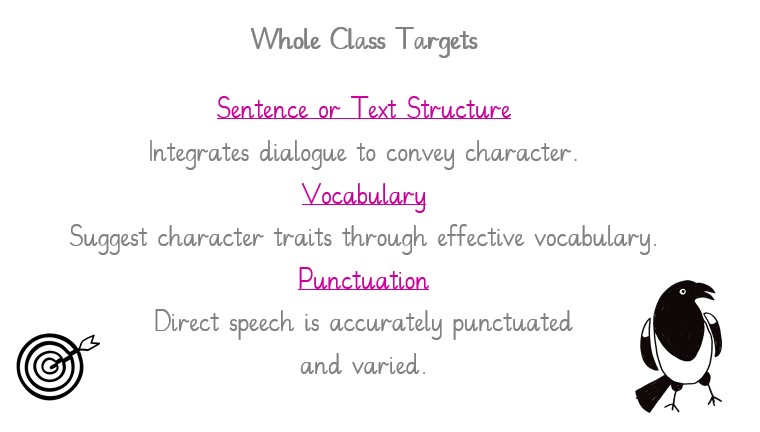
Summative Assessment of Writing using Glusburn’s Bespoke Writing Assessment Grids: Each term, teachers make a formal judgement on their pupils’ progress towards achieving the expected standard by the end of the academic year. This information is gathered throughout the term using any independent writing as evidence. To ensure that our judgements are accurate and fair, a set of bespoke writing assessment grids were created by the English lead in collaboration with teachers from every year group. These match the Glusburn Progression in Writing document and reflect the three areas we require teachers to create targets for as well as transcription. The assessment grids are broken down into five strands: Handwriting; Spelling; Punctuation; Grammar, Sentence Structure & Vocabulary; Composition, Purpose and Effect and Drafting, Editing and Proof Reading. In this way, the assessment grids guide teachers not only in their judgements of pupils’ writing but also in their planning of each strand ensuring full curriculum coverage. We decided to present the assessment grids displaying WTS, EXS and GDS horizontally across the page to support teachers in their focus on ‘gaps in learning’ using a small step approach and considering to master a particular writing skill: what comes before, what comes next? Some non-statutory statements were therefore added to WTS and GDS to support the small-step cumulative approach.
english assessment grids glusburn.pdf
Moderation of Writing Assessment: Our assessment process is assured through regular moderation:
- a) Shared year group teachers moderate judgements on a regular basis.
- b) Termly Whole School moderation allows cross year group networking.
- c) We invite schools locally to part take in cross school moderation in the summer term.
- d) ‘Pobble’ is used as an online platform to moderate nationally where approriate.

